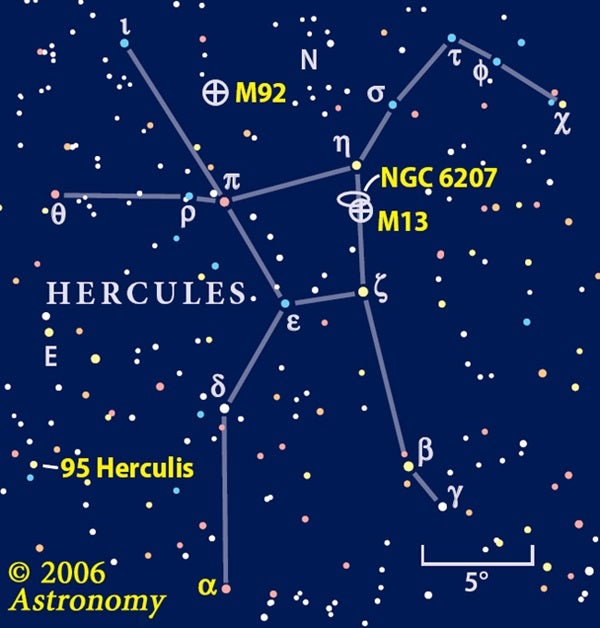Last month, Phil Harrington featured M13 in his binocular column (“It’s Superman!”). As he noted, M13 is easily found between the stars Eta (η) and Zeta (ζ) Herculis in the “Keystone” of Hercules.
If you’re lucky enough to live in a dark-sky area, you should be able to see M13 with the unaided eye (it shines at magnitude 5.8). Binoculars reveal a small circular patch of light, about 1/4° wide — half the apparent diameter of the Full Moon.
While I’m a big fan of small-aperture telescopes, I reluctantly acknowledge their shortcomings where globular clusters are concerned. Small scopes do little to enhance M13’s binocular appearance, merely enlarging the fuzzy ball. With a 3- or 4-inch scope and high magnification, you might be able to resolve the outer parts of M13. But to appreciate M13 or its kindred globulars in all their glory, you’ll need at least a 6-inch telescope.
Because I wanted those spectacular big-scope views of globular clusters, I purchased a 13.1-inch Dobsonian-mounted reflector in 1980. This is the telescope through which Michael viewed M13, and it’s the one I still use today whenever I want to get my M13 “fix.”
Most observers are so captivated by M13’s dramatic appearance that they fail to notice a faint, elongated smudge of light about ½° to the northeast. This “little fuzzy” is the 11th-magnitude galaxy NGC 6207. I’ve glimpsed it (barely) in a 3-inch telescope. When you’re looking at M13, you see light that crossed a void of some 20,000 light-years. When you turn your gaze to NGC 6207, you’re picking up light from an object 46 million light-years away.
Another overlooked deep-space target in Hercules is the globular cluster M92 (NGC 6341). This gem, slightly smaller and fainter than M13, lies roughly midway between Eta and Iota (ι) Herculis. Again, you’re looking at a small hazy ball if you view this globular with binoculars or a small scope, and a sparkling spherical stellar swarm if you apply a large telescope and high magnification.
Hercules offers plenty of intriguing targets for double-star enthusiasts. A particularly striking pair, Alpha (α) Herculis, combines a reddish-orange, magnitude 3.5 primary with a blue-green, magnitude 5.4 companion. Only 4.7″ separate the pair, so use a magnification of at least 100x for a clean, distinguishable split.
Another pair noted for its colors is 95 Herculis. This double star sports components of magnitudes 5.1 and 5.2, separated by a little more than 6″ — a gap easily breached by the smallest of telescopes (provided the optics are sound). To view both components comfortably, try a magnification of 70x to 100x.
Simple observing project
Would you like to try a simple observing project? Study 95 Herculis carefully and write down the colors you see of its component stars. No fair peeking in any observing guide! I don’t want observer bias to influence what you see.
E-mail me here describing the colors (if any) you see, as well as notes on telescope used, magnification, and sky conditions. I’ll report the results in a future column.











